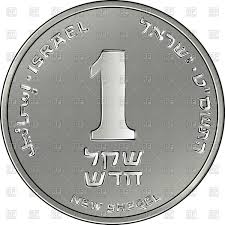The Israel Shekel
The origin of the name "shekel" (שקל) is from the ancient biblical currency by the same name. Shekel is any of several ancient units of weight or of currency in ancient Israel.
The earliest shekels were a unit of weight, used as other units such as grams and troy ounces for trading before the advent of coins. The shekel was common among western Semitic peoples. Moabites, Edomites, and Phoenicians used the shekel, although proper coinage developed very late. Carthaginian coinage was based on the shekel and may have preceded its home town of Tyre in issuing proper coins.
Coins were used and may have been invented by the early Anatolian traders who stamped their marks to avoid weighing each time used. Herodotus states that the first coinage was issued by Croesus, King of Lydia, spreading to the golden Daric (worth 20 sigloi or shekel),issued by the Persian Empire and the silver Athenian obol and drachma. Early coins were money stamped with an official seal to certify their weight. Silver ingots, some with markings were issued. Later authorities decided who designed coins.
As with many ancient units, the shekel  had a variety of values depending on era, government and region; weights between 7 and 17 grams and values of 11,14, and 17 grams are common. When used to pay laborers, recorded wages in the ancient world range widely. The Code of Hammurabi (circa 1800 BC) sets the value of unskilled labor at approximately ten shekels per year of work. Later, records within the Persian Empire (539-333 BC) give ranges from a minimum of two shekels per month for unskilled labor, to as high as seven to ten shekels per month in some records. A survival wage for an urban household during the Persian period would require at least 22 shekels of income per year.
had a variety of values depending on era, government and region; weights between 7 and 17 grams and values of 11,14, and 17 grams are common. When used to pay laborers, recorded wages in the ancient world range widely. The Code of Hammurabi (circa 1800 BC) sets the value of unskilled labor at approximately ten shekels per year of work. Later, records within the Persian Empire (539-333 BC) give ranges from a minimum of two shekels per month for unskilled labor, to as high as seven to ten shekels per month in some records. A survival wage for an urban household during the Persian period would require at least 22 shekels of income per year.
Exodus 30:24 notes that the measures of the ingredients for the holy anointing oil were to be calculated using the Shekel of the Sanctuary (see also Exodus 38:24–26, and similarly at Numbers 3:47 for payment for the redemption of 273 first-born males [nd at Numbers 7:12–88 for the offerings of the leaders of the tribes of Israel), suggesting that there were other common measures of shekel in use, or at least that the Temple authorities defined a standard for the shekel to be used for Temple purposes.

